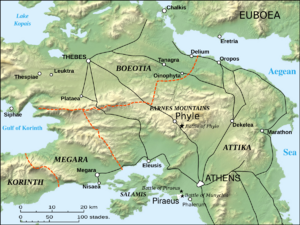Battle of Piraeus facts for kids
Quick facts for kids Battle of Piraeus |
|||||||
|---|---|---|---|---|---|---|---|
| Part of Phyle Campaign | |||||||
 Map showing the three battles of the Phyle Campaign |
|||||||
|
|||||||
| Belligerents | |||||||
| Athenian exiles | Sparta Thirty Tyrants |
||||||
| Commanders and leaders | |||||||
| Thrasybulus | Pausanias | ||||||
| Casualties and losses | |||||||
| Over 180 killed | Unknown | ||||||
The Battle of Piraeus happened in 403 BC. It was a fight between Athenian exiles and a Spartan army. The exiles had taken control of Piraeus, which was the port of Athens. They had just defeated a harsh government called the Thirty Tyrants.
The Spartans, led by King Pausanias, fought the exiles. The Spartans won the battle, but both sides lost many soldiers. After the battle, King Pausanias helped the two groups in Athens make peace. This led to Athens becoming a democracy again.
Why the Battle Happened
After the Peloponnesian War, Athens was ruled by a group called the Thirty Tyrants. This government was very unfair and cruel. Many Athenians had to leave their homes and become exiles.
In late 404 BC, a small group of these exiles, led by Thrasybulus, returned to Athens. They took over a strong fort called Phyle. They wanted to get rid of the Thirty Tyrants. Thrasybulus and his men won two battles against the Tyrants' forces.
After these wins, the Thirty Tyrants were removed from power. A new, slightly less harsh government, called the Ten, took over. But the Ten still didn't want to make peace with the exiles. The exiles now controlled Piraeus, the main port of Athens. Small fights kept happening between the two sides.
Both the Ten in Athens and the old Thirty Tyrants (who were now in a town called Eleusis) asked Sparta for help. Sparta was a very powerful city-state. Two important Spartan leaders had different ideas. Lysander wanted to fight the exiles. But King Pausanias wanted to find a peaceful solution. Pausanias convinced other Spartan leaders to send him with an army to Athens. His goal was to fix the situation.
The Battle Begins
When King Pausanias arrived in Athens, he told the exiles in Piraeus to leave. They refused to go. Pausanias got his army ready to attack, but he didn't start the fight right away.
The next day, some Athenian light troops from Piraeus attacked the Spartans. The Spartans were exploring the area near Piraeus. Pausanias sent his cavalry (soldiers on horseback) and young infantry (foot soldiers) to chase them. He followed with the rest of his army.
The Spartan cavalry and advance soldiers went into Piraeus. There, they met many more light troops from the city. The Spartans were pushed back and lost some men. Then, Thrasybulus led his main army of hoplites (heavy foot soldiers) out of the city. The Spartan hoplites fought them. After a while, the Spartans won the fight. About 150 of the exiles were killed. The exiles went back into Piraeus, and Pausanias returned to his camp. The fighting was over.
Making Peace in Athens
Even though Pausanias won the battle, he didn't keep fighting. Instead, he wanted to help the two Athenian groups make peace. He convinced both the exiles from Piraeus and the government in Athens to send people to Sparta to talk.
These people returned with 15 Spartan officials. These officials worked with Pausanias to find a way to end the conflict. Pausanias helped the Athenians agree to a deal. Most people were allowed to go back to their homes. Only the Thirty Tyrants and their closest helpers were not allowed to return. Anyone who felt unsafe could move to Eleusis.
Athens became a democracy again. Most people who had done wrong were forgiven. Eleusis stayed separate for a short time. But when it was found that the Thirty Tyrants were gathering an army there, Athens attacked. Eleusis then became part of Athens again.

